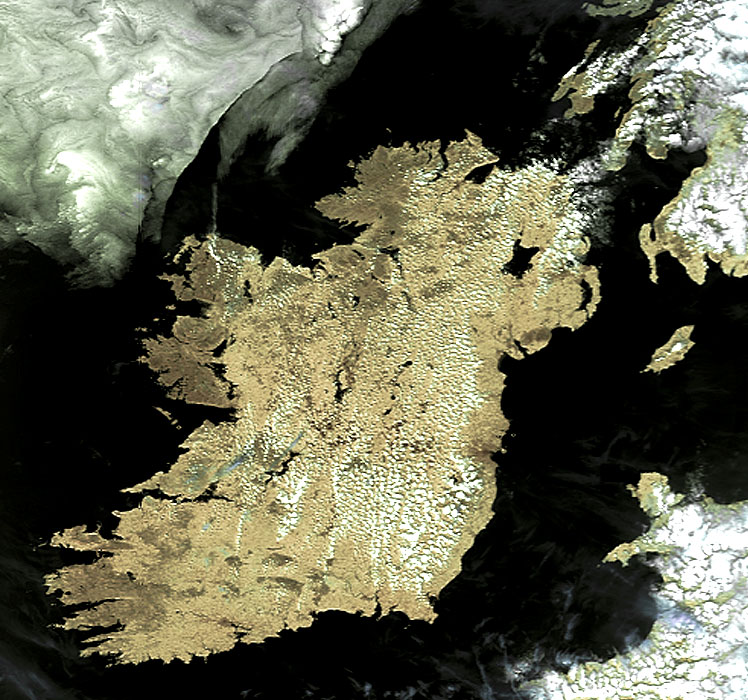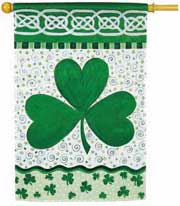Saint Patrick's Day

Ireland From Space
Across the globe, most people associate the seventeenth of March with shamrocks, wearing green, and celebrating - even if they're not Irish. Saint Patrick, the Patron Saint of Ireland, has become intertwined with Ireland and now it is difficult to think of him without thinking of Ireland After all, "everyone is Irish!" on St. Patrick's Day, according to an old Irish saying. Yet, even though grand celebrations are customary on St. Patrick's Day - with the grandest, by far, in Ireland - the day also holds a deeper meaning to many people. On St. Patrick's Day, nearly every business in Ireland is closed, with the exception of restaurants and pubs. It's a religious holiday, on which people attend mass and offer prayers for missionaries throughout the world, all in honor of Ireland's patron saint, Patrick.
Saint Patrick was a priest recognized for converting the Irish to Christianity during the 5th century. Ironically, St. Patrick was neither Irish, nor was his birth name Patrick. Historians believe his real name was Maewyn Succat, and he was born outside of Ireland in Wales, although some dispute that he could also have been either from Scotland or Roman Britain (the Romans controlled what is now Britain at the time of his birth). Only upon becoming a priest did he adopt the name Patrick (or Patricus).
The exact details and dates in Saint Patrick's life are disputed by historians, but the legend of St. Patrick is commonly shared by many. When Patrick was a teenager, he was captured by Irish marauders, from his native Wales, and sold into slavery in Ireland. He spent six years as a shepard, tending to his master's flocks of sheep. As a slave of pagan captors, it's said that Patrick turned to God for guidance and found strength in his faith. When he finally escaped from captivity, Patrick returned to Britain, determined to devote his life to the service of God. He traveled to France to train as a cleric, became a deacon, was later ordained as a priest, and eventually earned the title of a bishop. Patrick studied in the monastery under St. Germain, bishop of Auxerre for a period of twelve years. During his training he became aware that his calling was to convert the pagans to Christianity.
Patrick's wishes were to return to Ireland, to convert the native pagans to Christianity. But his superiors instead appointed St. Palladius. But two years later, Palladius transferred to Scotland. However, Patrick had already spent six years of his life among the Irish as a slave, he knew the Celtic language and was familiar with the pagan way of life. For these reasons, the Pope believed that Patrick would be the perfect missionary to go to Ireland in place of Palladius and preach the gospel. Patrick took the challenge and spent many years of his life converting people from their pagan beliefs and baptizing them into the Christian faith. This fact upset the Celtic Druids. Patrick was arrested several times, but escaped each time. He traveled throughout Ireland, establishing monasteries across the country. He also set up schools and churches which would aid him in his conversion of the Irish country to Christianity.
Although St. Patrick was not the first person to introduce Christianity to Ireland, he is credited with the conversion of Ireland to Christianity. Today, there are over 60 churches and cathedrals in Ireland alone that are dedicated to him, and even more in Brittany, Cornwall, Wales, and Scotland that are named after him.

A Shamrock
The shamrock is one and probably the most traditional icon associated with St. Patrick's Day. This is largely due to the legend of Ireland's patron saint. It is believed that St. Patrick used the three-leafed shamrock as a metaphor to explain the concept of the Trinity. While preaching to a congregation, St. Patrick plucked a shamrock from the grass at his feet in order to illustrate the true existence of the Trinity in everyday life. He used it in his sermons to represent how the Father, the Son, and the Holy Spirit could all exist as separate elements of the same entity. Also, green, the color of the shamrock, has become a lasting symbol of St. Patrick's Day, representing the color of spring and of Ireland. His followers adopted the custom of wearing a shamrock on his feast day.
There is also much belief that Patrick was capable of raising people from the dead. In addition, he is said to have given a sermon from a hilltop that drove all the snakes from Ireland. Of course, no snakes were ever native to Ireland, and some people think this is a metaphor for the conversion of the pagans to Christiainity.
The fact that St. Patrick's Day is one of the only national holidays given any recognition outside its native country is an indication of Irish influence throughout the world. Saint Patrick's Day parades, for example, originated in America rather than Ireland. The Charitable Irish Society of Boston organized the first St. Patrick's Day parade in 1737. Today, these parades are held in over 100 U.S. cities - for no better reason than to raise a glass to the saint and celebrate Irish tradition!
St. Patrick's mission lasted for thirty years before Patrick retired to County Down. It is believed that he died on March 17 AD461, and for that reason, the day is set aside in remembrance of him. St Patrick is buried in Croagh Patrick ,which is located in County Mayor.
The luck of the Irish
Want to be lucky this St. Patrick's Day? Follow this advice:
1. Find a four-leaf clover.
St. Patrick used the shamrock leaf to symbolize the Trinity, and today many people wear a shamrock to commemorate Saint Patrick's Day.
2. Wear green (so you don't get pinched).
So why do we all wear green?
Probably because you'll be pinched if you don't! School children started this tradition. Green is also the color of spring, the shamrock and is connected with hope and nature.
3. Kiss the blarney stone.
Blarney Castle is located in County Cork, Ireland. Built in 1446 by Cormac Laidhim McCarthy (Lord of Muskerry) the Blarney stone is located in the southern tower wall between the main castle wall and the parapet. In order to kiss the stone one has to lie on their back and bend backward (and downward), holding iron bars for support. It is said that the Blarney stone has magical properties. As legend has it an old woman cast a spell on the stone to reward a king who had saved her from drowning. Kissing the stone gave the king the ability to speak sweetly and convincingly. Thus It is believed that Kissing the Stone will give you the "Gift of the Gab".
4. Catch a Leprechaun if you can.
Just what does a Leprechaun look like and why are they so special? A Leprechaun (Irish fairy) looks like a little old man. He's about 2 feet tall and dresses like a shoemaker with a cocked hat and leather apron. A Leprechaun's personality is described as aloof and unfriendly. They live alone and pass the time by making shoes. They're special because they also possess a hidden pot of gold. They are also known to be mischievous and in Ireland they are sometimes also referred to as "Wee Folk".
If you listen closely for the sound of their hammer you might be able to capture one. If you do you can force him (with the threat of bodily violence) to reveal where he's hidden his treasure. Be careful! Do not take your eyes off him for if you do he will surely vanish and your hopes of finding his treasure will vanish with him.
 An Irish Blessing
An Irish Blessing(from SG - The most lovable Irishman at OTF. *coughs*)
May your neighbours
respect you,
Trouble neglect you,
Angels protect you,
And Heaven accept you.